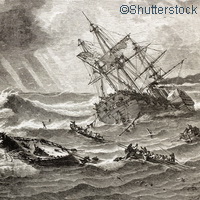Maritime disasters: are women and children really always given priority?
With commemorative events happening all around the world to mark 100 years since the Titanic went down, its legacy as represented in both the history books and popular culture has shaped how we view what happens in a maritime disaster. Now, a team of Swedish scientists claims that one of these widely held beliefs about maritime disasters - that women and children are always the first to be saved, was a phenomenon unique to the Titanic. When the Titanic collided with an iceberg in the North Atlantic during her maiden voyage from Southampton in the United Kingdom to New York in the United States on 15 April 1912 the captain ordered that the men stand back and give priority to women and children to board the lifeboats. He also ordered that any man disobeying these orders be shot. As a result 70% of the women and children were saved compared to only 20% of the men, securing Titanic's place in the history books as a prime example of chivalry at sea. However Titanic seems to have been an exception to the rule, as findings from two Uppsala University researchers, Mikael Elinder and Oscar Erixon, show. Mikael Elinder comments: 'It is expected that the crew should rescue passengers, but our results show that captains and crew are more likely to survive than passengers. We also found that women and children were more inclined to die than men. It appears as if it is every man for himself. The evacuation of the Titanic was exceptional, but has spurred a long-lived myth that women and children will be saved first in disasters.' They analysed a database containing information about passengers and crew from 18 of the most notable shipwrecks that occurred between 1852 and 2011, and found that in most maritime disaster situations the survival rate of women was substantially lower than the survival rate of men. Children had the lowest survival rate, while the highest survival rates were observed for crew and captains. Their study is one of the most extensive analyses of survival patterns in maritime disasters ever carried out with information on the fates of more than 15000 people used. Previous studies have only looked at the Titanic and RMS Lusitania, which ran aground off Ireland in 1915. Yet despite Titanic being the exception and 'every man for himself' being a more apt way to describe the typical ensuing panic as a maritime disaster unfolds, the belief that in a disaster situation women and children will be saved first remains prevalent in the common consciousness. The scientists found that on the ships where the captain gave the order 'women and children first', the difference in survival rates between men and women was lower. But women only survived to a higher extent than men when this order was enforced with the threat of violence. The team suggest that the Titanic was so different due to the captains' severe orders. The study therefore highlights the important role leaders play in disasters. The researchers say it remains unusual for a captain to give a Titanic-style order, and that it is more common for a captain just to leave the ship and save themselves before the passengers. Mikael Elinder adds: 'Although maritime disasters are tragic events they can contribute to our understanding of how people behave under extreme stress and when it is a matter of life and death. The behavior of the captain in the recent and widely discussed grounding of the Costa Concordia is thus not an exception, but rather quite common in maritime disasters.'For more information, please visit:Uppsala University:http://www.uu.se/en
Countries
Sweden



